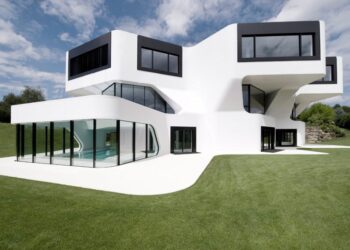Investing in Next-Generation Structures
The landscape of real estate investment is undergoing a profound transformation. The days of simply valuing properties based on location, square footage, and traditional aesthetic appeal are over. A new era has dawned, one where the most valuable assets are not just buildings, but intelligent, sustainable, and resilient ecosystems. Investors are increasingly shifting their focus to next-generation structures, properties that are defined by their integration of advanced technology, their commitment to environmental sustainability, and their design for human well-being. This isn’t just a fleeting trend; it’s a fundamental recalibration of risk, return, and long-term value in the global market. Understanding the core principles of these innovative buildings is key to making a profitable and responsible investment in the future of our built environment.
This revolution is driven by a convergence of factors, including mounting climate change concerns, rapid technological advancements, and the evolving demands of a modern workforce and population. From smart homes that optimize energy consumption to commercial buildings that prioritize occupant health, these next-generation structures offer a compelling value proposition that traditional properties simply cannot match. This comprehensive guide will dissect the essential characteristics that define these new assets, providing a roadmap for investors looking to position themselves at the forefront of this lucrative and impactful market.
I. The Pillars of a Next-Generation Investment
A next-generation structure is not defined by a single feature but by the seamless integration of three core pillars: technology, sustainability, and human-centric design. Together, these elements create a whole that is greater than the sum of its parts, offering unparalleled long-term value.
A. Smart and Connected Technology: The foundation of a next-generation structure is its digital infrastructure. These buildings are not just wired; they are intelligent, with an intricate network of sensors, actuators, and software that work together to optimize performance and enhance the user experience.
- Building Automation Systems (BAS): These systems act as the building’s central nervous system, automating and controlling crucial functions like HVAC, lighting, security, and fire safety. A smart BAS can learn from occupancy patterns, adjusting temperature and lighting in real-time to save energy without sacrificing comfort. For example, lights in a conference room can automatically dim when it’s unoccupied, and the air conditioning can be scaled back during non-business hours, leading to significant operational savings.
- Internet of Things (IoT) Integration: The proliferation of IoT devices allows buildings to collect vast amounts of data. This data, when analyzed, provides powerful insights into energy usage, maintenance needs, and occupant behavior. Investors can use this information to predict and address potential issues before they become major expenses, a form of predictive maintenance that drastically lowers long-term operational costs.
- Enhanced Security and Access Control: Beyond traditional alarms, next-generation buildings feature advanced security systems with biometric access, real-time surveillance, and intelligent threat detection. This not only protects the asset but also provides a higher level of safety for tenants, a key selling point in a competitive market.
 B. Sustainability and Resilience: In today’s world, an environmentally responsible building is a financially responsible one. Next-generation structures are designed to minimize their environmental footprint while maximizing their durability and resilience to future climate challenges.
B. Sustainability and Resilience: In today’s world, an environmentally responsible building is a financially responsible one. Next-generation structures are designed to minimize their environmental footprint while maximizing their durability and resilience to future climate challenges.
- Net-Zero Energy and Carbon Neutrality: The ultimate goal for many new builds is net-zero energy (NZE) status, where a building generates as much renewable energy on-site as it consumes over a year. This is achieved through a combination of highly efficient design, superior insulation, and on-site power generation, typically with solar panels. A building’s value is directly linked to its energy independence, making it a resilient asset against volatile energy markets.
- Water Conservation and Management: Smart water systems monitor usage, detect leaks, and can even recycle rainwater for non-potable uses. These systems not only save money but also contribute to a building’s sustainability credentials, a growing factor in investment decisions.
- Resilience to Climate Change: Next-generation structures are built to withstand future climate impacts, such as extreme weather and rising sea levels. This includes using climate-appropriate materials, designing for passive cooling and heating, and incorporating features like flood barriers and wind-resistant roofing. An investor can confidently acquire these assets knowing they are built to last.
C. Human-Centric Design: The value of a building is ultimately determined by the people who occupy it. Next-generation structures are designed with a deep understanding of human psychology, health, and well-being.
- Biophilic Design: This design philosophy integrates natural elements into the built environment to reduce stress and improve productivity. This includes features like living walls, indoor water features, and expansive windows that provide a direct connection to nature. For commercial properties, this translates to higher employee satisfaction and reduced absenteeism, while for residential properties, it creates a more desirable living space.
- Enhanced Indoor Air Quality (IAQ): Advanced HVAC systems with high-efficiency filters and air purifiers are standard. These systems not only remove pollutants but also regulate humidity and temperature, creating a healthier and more comfortable environment. For investors, this translates to higher tenant retention and a lower risk of health-related liability.
- Flexible and Adaptable Spaces: The modern world demands flexibility. Next-generation buildings feature modular layouts, movable walls, and dynamic furniture that can be reconfigured to suit different needs, from collaborative workspaces to private offices or a home gym to a guest room. This adaptability ensures the property remains relevant and marketable as trends evolve.
II. The Financial Case for Next-Generation Investment
Investing in these advanced structures is not just an act of corporate social responsibility; it is a shrewd financial decision with a clear return on investment.
A. Higher Capital Value and Rent Premiums: Next-generation properties command higher sales prices and can justify significant rent premiums. Tenants, whether commercial or residential, are willing to pay more for a space that offers better health benefits, lower utility bills, and a superior user experience. This increased demand translates to a stronger and more stable asset. A report by the World Green Building Council found that green buildings consistently have higher occupancy rates and a greater return on investment.
B. Reduced Operational and Maintenance Costs: The advanced systems and sustainable design of these buildings lead to massive savings on day-to-day operations. Energy and water bills are significantly lower, and the use of predictive maintenance reduces the cost and frequency of repairs. Over the life of a building, these savings can amount to millions of dollars, making the initial investment a minor consideration in the long run.
C. Future-Proofing the Asset: As regulations tighten and consumer preferences continue to shift towards sustainability, traditional buildings face the risk of becoming stranded assets, properties that have lost value due to changing market conditions. Investing in a next-generation structure is a way to future-proof a portfolio, ensuring its relevance and value for decades to come.
III. Navigating the Investment Landscape
For investors interested in this market, there are several key considerations and strategic approaches.
 A. Due Diligence on Technology and Systems: The “smart” label can be used loosely. Investors must conduct thorough due diligence to verify the quality and integration of a building’s technology. This includes reviewing the systems’ interoperability, scalability, and long-term support from manufacturers. A building with a fragmented system of different brands will not be as efficient or valuable as one with a unified, well-designed platform.
A. Due Diligence on Technology and Systems: The “smart” label can be used loosely. Investors must conduct thorough due diligence to verify the quality and integration of a building’s technology. This includes reviewing the systems’ interoperability, scalability, and long-term support from manufacturers. A building with a fragmented system of different brands will not be as efficient or valuable as one with a unified, well-designed platform.
B. Partnering with Specialized Architects and Developers: The design and construction of next-generation structures require specialized expertise. Investors should partner with architects and developers who have a proven track record in green building, intelligent design, and human-centric principles. Their knowledge is invaluable in ensuring the project meets its ambitious goals.
C. Leveraging Green Finance Options: A growing number of financial institutions are offering green loans and sustainability-linked bonds to fund projects with environmental benefits. These financing options often come with more favorable terms and lower interest rates, making it easier to fund these innovative projects and further improving their ROI.
Conclusion
The investment thesis for next-generation structures is robust and clear. They are not a fad, but the logical evolution of the built environment in response to a changing world. By focusing on buildings that are technologically advanced, environmentally responsible, and designed for human well-being, investors can create portfolios that are not only highly profitable but also resilient and impactful. The old rules of real estate have been rewritten. The new measure of value is not just in what a building is, but in what it does—how it performs, how it impacts the planet, and how it serves the people within its walls. For forward-thinking investors, the future of real estate is not a question of if, but of when to invest in a brighter, smarter, and more sustainable world.







